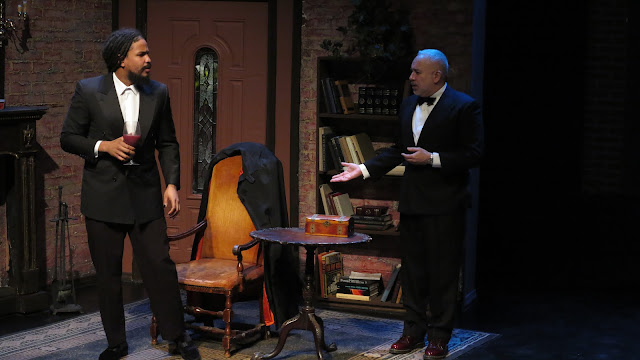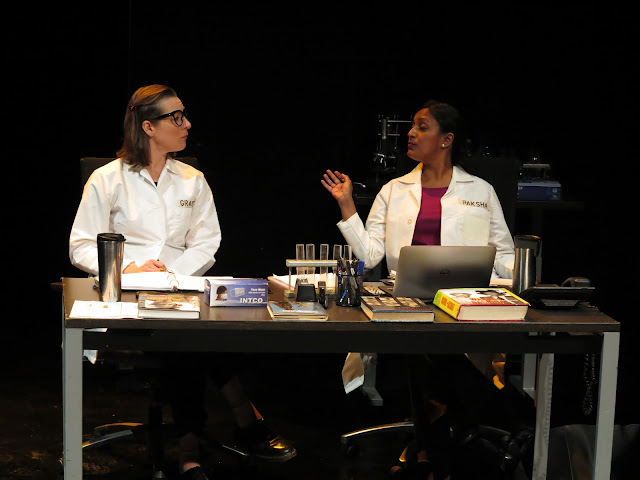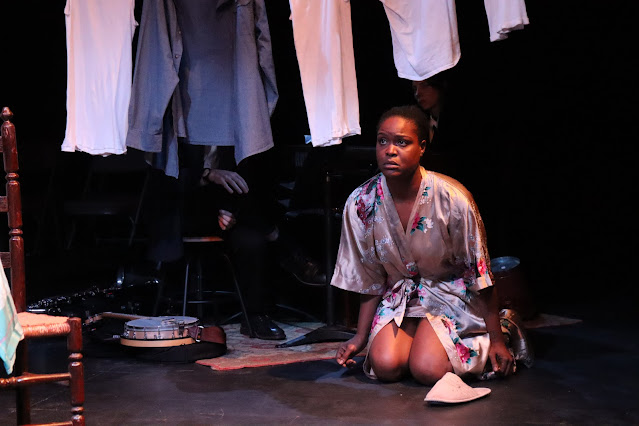The Slave Who Loved Caviar
Written by Ishmael Reed
Directed by Carla Blank
155 1st Ave., Manhattan, NYC
December 23, 2021-January 9, 2022
 |
| L-R: vampire Baron De Whit (Raul Diaz) and the Baron's agent, Antonio Wolfe (Jesse Bueno). Photo by Jonathan Slaff. |
Karl Marx famously compared the workings of capitalism to vampirism, and The Slave Who Loved Caviar, bringing the metaphor of vampirism to bear specifically on the capitalism of the art world, and even more specifically, on the relationship between artists Andy Warhol and Jean-Michel Basquiat. Making its world premiere at Theater for the New City, The Slave Who Loved Caviar is the latest play from storied novelist, essayist, critic, playwright, musician, songwriter, professor, publisher, and more Ishmael Reed. Directed by frequent Reed collaborator Carla Blank, herself a director, dramaturge, writer, and editor, and featuring original music composed and performed by Reed, The Slave Who Loved Caviar is being presented in hybrid format throughout its run so that audiences can experience its encyclopedic deep dive into the exploitation of Basquiat by Warhol and his circle either in person or via livestream. |
| Detective Mary Van Helsing (Roz Fox) rescues Jennifer Blue (Kenya Wilson), one of Baron De Whit's Victims. Photo by Jonathan Slaff. |
The Slave Who Loved Caviar is primarily organized around two parallel investigations, an arrangement reflected in the set design: to one side is a brick-walled drawing room belonging to Baron De Whit (Raul Diaz) and to the other a police forensics lab, with a large screen between these two areas for projections and silhouette work. The Baron, a well-heeled and well-connected son of Dracula with a Bela Lugosi-impersonator accent, is under scrutiny by dogged Detective Mary Van Helsing (Roz Fox) for the tendency of people to disappear after entering his residence, the latest being Jennifer Blue (Kenya Wilson), a young woman who never came home from the Baron's exclusive Halloween party. The Baron is also an artist, but his style of painting has gone out of fashion, causing him cash flow problems, so his servant-cum-agent Antonio Wolfe (a very funny Jesse Bueno) suggests a plan to turn hip-hop painter Young Blood (Brian Simmons) into their own personal Basquiat, plotting to relegate him to the basement and fuel him with caviar and cocaine so that he might churn out work that will, via the most superficial element of 'collaboration,' revitalize the Baron's career. In recapitulating Warhol's relationship with Basquiat, the Baron's relationship with Young Blood offers at least the possibility of a symbolic do-over of Basquiat's tragic end, a possibility contrasted by a scene that imagines a cautionary dream by Basquiat of Richard Pryor (played in loose-limbed silhouette by Daniel Lugo and voiced by Maurice Carlton)—whose own life, career, and death provides resonant parallels to Basquiat's—that only deepens the sense of tragedy.
 |
| Forensic experts: Laura Robards and Monisha Shiva. Photo by Jonathan Slaff. |
At the same time that Detective Van Helsing is looking into the Baron, she is also heading an investigation into whether Basquiat's death could be determined to be foul play—more specifically, foul play by (racist) exploitation and neglect not only, if most egregiously, by Warhol but also his circle, art critics, and art dealers. Charged with assembling the evidence for this investigation are forensic experts Raksha (Monisha Shiva) and Grace (Laura Robards, who invests Grace with a distinct personality even while delivering detailed informational passages). The evidence here comes not from analyzing blood spatter or decomposition, but from textual research (if this itself does not clearly indicate the play's heightened, postmodern approach, they cite Reed himself in their results). While outside the realm of forensics experts, these professionals creating their dossiers for Van Helsing shows that evidence of foul play can come from outside a crime scene.
 |
| Young Blood (Brian Anthony Simmons) and abstract painter Jack Brooks (Robert E. Turner). Photo by Jonathan Slaff. |
The result of these parallel investigations is something like a mixture of scholarly biography and a class on (the politics) of art history by way of an often-comic supernatural detective story. The play's central metaphor may be vampirism, but around this center it creates a dense tapestry of interconnections, including everything from classical analogs (Grace is also an expert in classical Greece and Rome, but wisely steered clear of a career as a Classics professor), ancient precursors of the Cinderella myth, and Bram Stoker's childhood to how we react differently to missing white or Black women, whether police officers from marginalized groups can or do affect change, and counternarratives to eurocentric art criticism. The play, for example, draws a line from Basquiat's labor conditions to forced cocaine use by Black slaves and workers (giving an extra dimension to references to cocaine as "The White Lady"), and debates the racial and generational politics of modes of painting in an excellent scene, one of the most traditionally character-driven, between Young Blood and Jack Brooks (an excellent Robert Turner), whose style of painting has, like the Baron's, been supplanted by newer movements. While its avenues of exploration branch out expansively, at its core,
The Slave Who Loved Caviar offers a hefty corrective (it runs a solid two hours and forty minutes with intermission) to the way(s) that Basquiat has been and continues to be (re)presented.
-John R. Ziegler and Leah Richards







Comments
Post a Comment